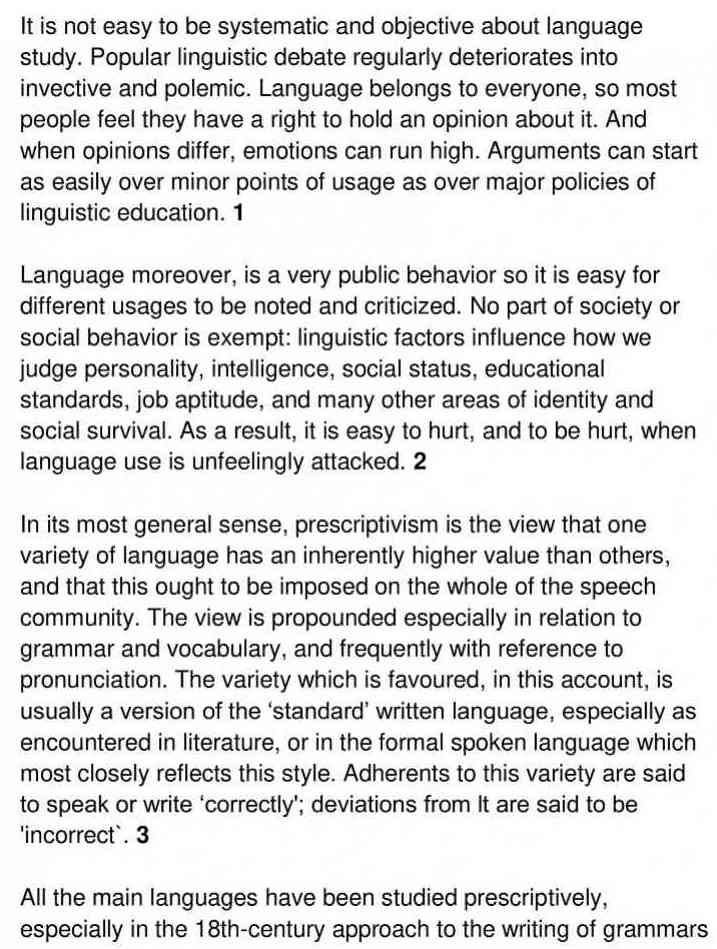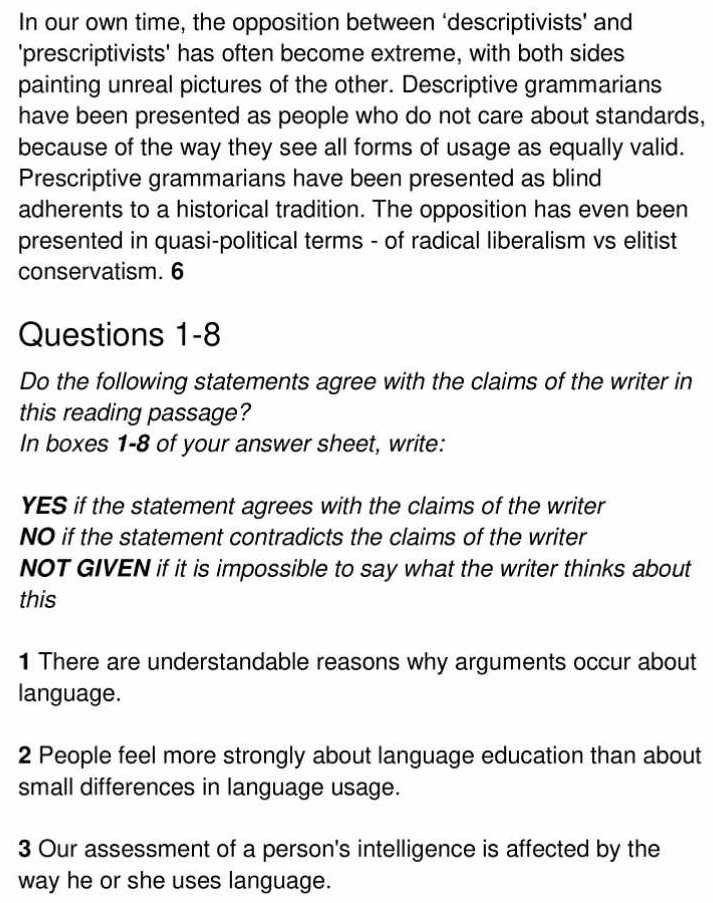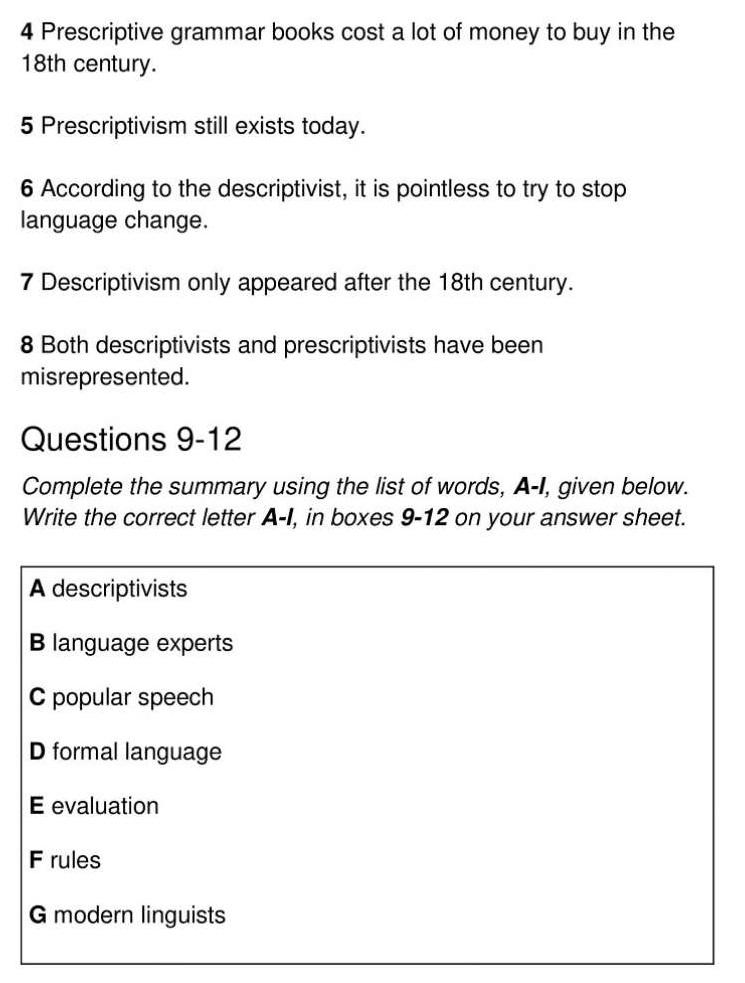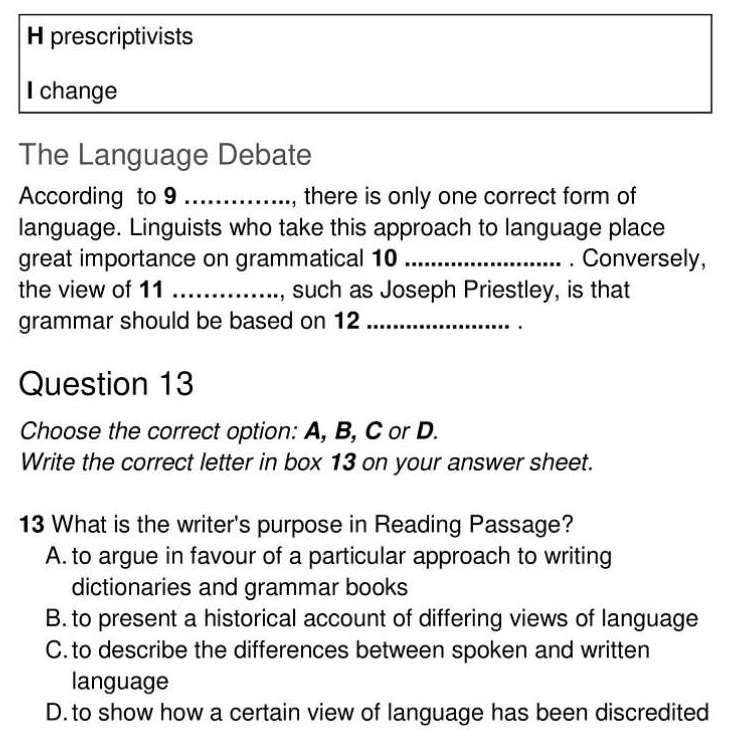Attitudes to Language – IELTS Reading Answers
6 min read
Updated On
-
Copy link
Table of Contents

Limited-Time Offer : Access a FREE 10-Day IELTS Study Plan!
The Academic passage ‘Attitudes to Language’ is a reading passage that appeared in an IELTS Test.
Ideally, you should not spend more than 20 minutes on a passage. Let’s see how easy this passage is for you and if you’re able to make it in 20 minutes. If not, try more IELTS reading practice tests from IELTSMaterial.com
Attitudes to Language





Answers
The answers to questions 1-13 are given below along with their explanations.
| Question Number | Answer | Explanation |
| 1 | YES | Paragraph 1 suggests that language belongs to everyone, so most people feel they have a right to hold an opinion about it. And when opinions differ (arguments), ‘emotions can run high’ (understandable reasons). Arguments can start as easily over minor points of usage as over major policies of linguistic education. As the statement agrees with the claims of the writer, the answer is ‘YES’. |
| 2 | NO | Paragraph 1 states that ‘arguments can start as easily’ over ‘minor points of usage’ (small differences in language usage) ‘as over’ (equally) ‘major policies of linguistic education’ (language education). So, both language education and minor language usages are equally treated and there is no preference of one over the other. As the statement contradicts the claims of the writer, the answer is ‘NO’. |
| 3 | YES | Paragraph 2 conveys that ‘linguistic factors’ (the way he or she uses language) ‘influence’ (affected) ‘how we ‘judge’ (assessment) personality, ‘intelligence’, social status, educational standards, job aptitude, and many other areas of identity and social survival’.As the statement agrees with the claims of the writer, the answer is ‘YES’. |
Unlock Answers
| 4 | NOT GIVEN | In paragraph 4, it is given that all the main languages have been studied prescriptively, especially in the 18th century approach to the writing of grammars and dictionaries. Further, in paragraph 5, it is added that it is the task of the grammarian to describe, not prescribe to record the facts of linguistic diversity, and not to attempt the impossible tasks of evaluating language variation or halting language change. In the second half of the 18th century, we already found advocates of this view. Thus, as there is no mention of prescriptive grammar books being costly, the answer is ‘NOT GIVEN’. |
| 5 | YES | Paragraph 4 tells us that the authoritarian nature of approach of early grammarians is best characterised by its reliance on ‘rules’ of grammar. Some ‘usages are ‘prescribed,’ to be learnt and followed accurately (prescriptivism). Later, in paragraph 5, it is given that ‘these attitudes’ (of prescriptivism) ‘are still with us’, and they motivate a widespread concern that linguistic standards should be maintained. As the statement agrees with the claims of the writer, the answer is ‘YES’. |
| 6 | YES | Paragraph 5 discusses that there is an alternative point of view (of descriptivists ) that is concerned less with standards than with the facts of linguistic usage. This approach is summarised in the statement that it is the task of the grammarian to describe, not prescribe to record the facts of linguistic diversity, and not to attempt the ‘impossible tasks’ (pointless) of evaluating language variation or ‘halting language change’ (stop language change). As the statement agrees with the claims of the writer, the answer is ‘YES’. |
| 7 | NO | Paragraph 5 communicates that there is an alternative point of view which is summarised in the statement that it is the ‘task of the grammarian to describe’ (descriptivism ) , not prescribe to record the facts of linguistic diversity, and not to attempt the impossible tasks of evaluating language variation or halting language change. ‘In the second half of the 18th century, we already find advocates of this view’, such as Joseph Priestiey. As the statement contradicts the claims of the writer, the answer is ‘NO’. |
| 8 | YES | Paragraph 6 reveals that in our own time, the opposition between ‘descriptivists’ and ‘prescriptivists’ has often become extreme, with ‘both sides’ (descriptivists and prescriptivists) ‘painting unreal pictures of the other’ (misrepresented). As the statement agrees with the claims of the writer, the answer is ‘YES’. |
| 9 | H | Paragraph 3 mentions that in its most general sense, ‘prescriptivism’ is the view that ‘one variety of language has an inherently higher value than others’ (only one correct form of language). Hence, the answer is ‘H’ (prescriptivists). |
| 10 | F | Paragraph 4 claims that the authoritarian nature of the approach is ‘best characterised by its reliance’ (place great importance) on ‘‘rules’ of grammar’ (grammatical rules). Some usages are ‘prescribed,’ to be learnt and followed accurately’ (prescriptivism). Hence, the answer is ‘F’ (rules). |
| 11 | A | Paragraph 5 shares the fact that there is an ‘alternative point of view’ which is summarised in the statement that it is the ‘task of the grammarian to describe, not prescribe’ (descriptivism) to record the facts of linguistic diversity, and not to attempt the impossible tasks of evaluating language variation or halting language change. In the second half of the 18th century, we already find ‘advocates’ (descriptivists) ‘of this view, such as Joseph Priestiey’. Hence, the answer is ‘A’ (descriptivists). |
| 12 | C | Paragraph 5 informs that in the second half of the 18th century, we already find ‘advocates of this view, such as Joseph Priestiey’ (descriptivists), whose Rudiments of English Grammar (1761) insists that ‘the custom of speaking’ (popular speech) is the original and only just standard of any language. Hence, the answer is ‘C’ (popular speech). |
| 13 | B | In paragraph 1, the writer expresses his view that ‘language belongs to everyone’, so most ‘people feel they have a right to hold an opinion about it’. In paragraph 3, it is added that ‘prescriptivism is the view that one variety of language has an inherently higher value than others’, and that this ought to be imposed on the whole of the speech community. In the fourth paragraph there is a mention of an ‘alternative point of view’ that is concerned less with standards than with the facts of linguistic usage. This ‘approach is summarised in the statement that it is the task of the grammarian to describe, not prescribe’ to record the facts of linguistic diversity, and not to attempt the impossible tasks of evaluating language variation or halting language change. Finally, in the final paragraph, the writer tells that the opposition between ‘descriptivists’ and ‘prescriptivists’ has often become extreme and has even been presented in quasi-political terms – of radical liberalism vs elitist conservatism. So, throughout the passage, there are various historical mentions of different views on language. Hence, the answer is ‘B’ (to present a historical account of differing views of language). |
Check More IELTS Reading Answers
Also check :
Practice IELTS Reading based on question types

Start Preparing for IELTS: Get Your 10-Day Study Plan Today!
Recent Articles

Nehasri Ravishenbagam

Haniya Yashfeen

Haniya Yashfeen

Haniya Yashfeen




Post your Comments